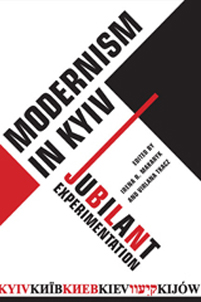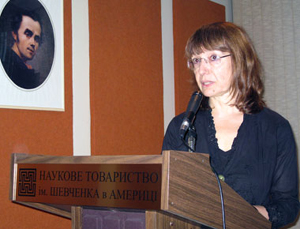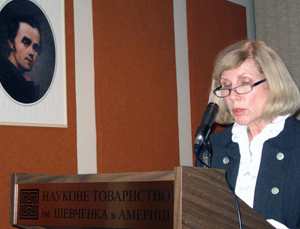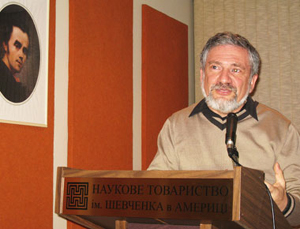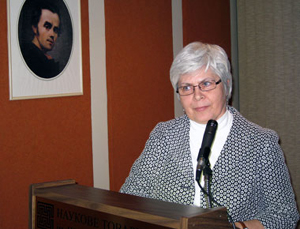|
MODERNISM IN KYIV GENNADY ESTRAIKH (New York University) MAYHILL C. FOWLER (Princeton University) IRENA R. MAKARYK (University of Ottawa) MYROSLAVA MUDRAK (Ohio State University) VIRLANA TKACZ (Yara Arts Group)
|
Modernism in KyivIntroduction
On Saturday November 13, 2010 the book Modernism in Kyiv: Jubilant Experimentation which was recently published by University of Toronto Press was launched at the Shevchenko Scientific Society. The book celebrates the work of artists who created Modernism in Kyiv embracing all the fields and reaching across the cultures. It includes 20 essays on the city of Kyiv, the music, theatre, dance, art, literature, cultural politics and the philosophy that inspired these creations. There are 21 color reproductions of the art and over 330 photos of the people, places and art inserted in the essays where these are discussed. The book is in English and the essays were written by scholars from America, Canada, France, Russian and Ukraine. Five contributors to the book, including the two editors, took part in a conference on Modernism in Kyiv. Three of the speaker discussed work of Les Kurbas, a Ukrainian theatre director who was at the center of the movement and a pivotal figure in the book. Virlana Tkacz outlined how Kurbas shifted the definition of Ukrainian theatre in both the Young Theatre and the Berezil Artistic Association and how these shifts reflected trends in the theatrical world. She then discussed in detail his innovative use of film in the stage production of Jimmie Higgins, a show Kurbas had dramatized on the basis of Upton Sinclair’s novel. Her presentation, accompanied by projected images, focused on two scenes in the production. In the explosion scene film and stage action was intercut to portray the explosion of emotions inside one person, creating modern multifocal portrait on stage. In the torture scene, Kurbas’s used the language of film, but staged the scene using only theatre means, revealing new ways of looking at the stage space. Irena Makaryk discussed the influential Paris Exposition des arts décoratifs et industriels (1925) in which the Berezil Theatre took part. Over 15 million visitors viewed the displays, including the Soviet theatre displays which were considered the most radical of the whole exposition. Vadym Meller came away with the gold medal for his maquette of The Union Secretary (by LeRoy Scott). Photos, maquettes and drawings from productions of Les Kurbas’s Berezil formed a considerable part of the Soviet exposition and impressed the viewers; so much so that, the following year, the international theatre exhibition was brought to New York. While the world was impressed with the avant-garde stage designs, no one knew that the Berezil theatre was Ukrainian. No visas were issued to the members of the Berezil and the published guidebooks simply listed all the participants as “Russians.” Mayhill Fowler’s paper examined the category of the "official artist," through the lens of Les Kurbas' production of Ivan Mykytenko's play, Dyktatura. In this 1930 production Kurbas made use of new cinema techniques, song, and stage images to transform a straightforward text into a theatrical experience. The scandal over the production reveals how Kurbas was increasingly at odds with general trends in Soviet culture, especially in advocating the separation between artists and the state, between arts and politics. Gennady Eistraikh’s topic was the dream of Jewish autonomy born in the early post-1917 period of Ukraine’s independence which ultimately, in the Soviet Ukrainian reality, materialized in territorial and institutional Yiddish cultural pockets. The framework of Soviet organizations and institutions formed an environment, which was conductive to cooperation between Yiddish and Ukrainian intellectuals. Importantly, the majority of Yiddish cultural organizations were segments of general Ukrainian bodies, such as publishing houses and educational institutions. Even the Ukrainian cinematography had a Yiddish sector. Professor Eistraikh outlined the stages of the development of Yiddish literature n Kyiv and spoke about the translations that were made between Ukrainian and Yiddish literatures. Cooperation between Yiddish and Ukrainian theater cultures developed initially very slowly. Only in the 1930s plays by Ukrainian authors, most notably Oleksander Korniichuk, began to appear in Yiddish theaters’ repertoire. True, a close friendship linked Solomon Mikhoels, director of the Moscow State Yiddish Theater, with Les Kurbas; the latter worked also with the Moscow Hebrew theater Habima. For the 1935 production of King Lear, which was the most famous performance in the history of the Moscow State Yiddish Theater, Mikhoels invited Les Kurbas to stage the production. Kurbas’s arrest in 1934 delayed the scheduled fall 1934 premiere and forced the theater to search for a new director.
In the spring of 1914, Oleksandr Bohomazov (1880-1930) participated in the “Kil’tse” [Ring] exhibition in Kyiv—an historic display of unprecedented modernist works by local artists. As unprepared as the Kyiv public was to deal with the New Art, the exhibition received widespread attention in the press, which recognized that earlier forays into every existing modernist orientation—from Impressionism to Symbolism—had reached a point of synthesis, culminating in a new, sustained expression of modernity defined by Cubist formalism and Futurist dynamism. Bohomazov, along with Alexandra Exter, had come to personify the Kyiv brand of Cubo-Futurism, which was codified in a lengthy theoretical treatise that Bohomazov completed at Boyarka, outside of Kyiv, at the end of that year. In this extensive tract entitled “Painting and Elements,” Bohomazov laid out a methodical analysis of the inherent pictorial properties of painting that capture and deliver modernist, urban energies. By focusing on a handful of paintings that Bohomazov completed during the critical 1914 period, Prof. Myroslava M. Mudrak’s presentation offered a glimpse into the complexity of Bohomazov’s theory and his importance to Kyiv modernism as a whole. |
More:
on book Modernism in Kyiv: Jubilant Experimentation
edited by Irena Makaryk and Virlana Tkacz, University of Toronto Press, 2010
List of related events launching Modernism in Kyiv
BRAMA, Inc.
Copyright (c)1995-2010 Yara Arts Group; all rights reserved.
|
